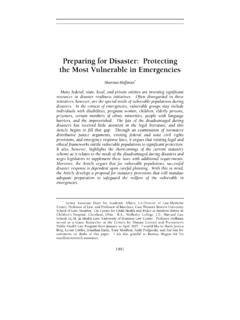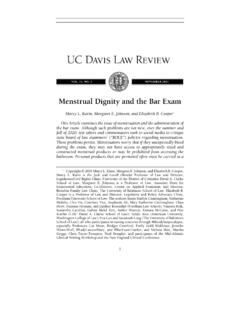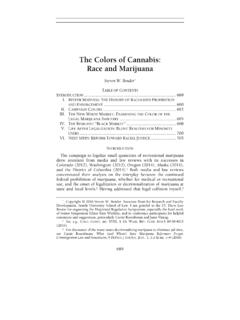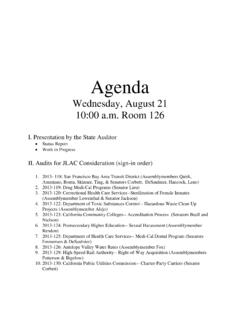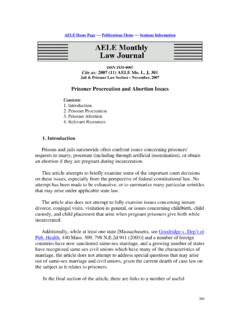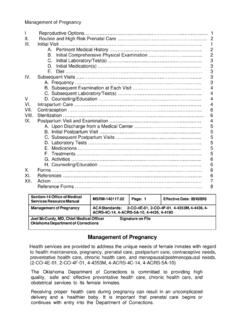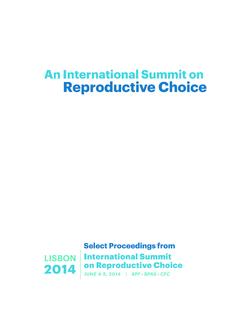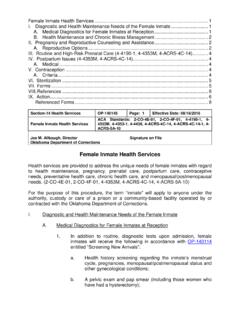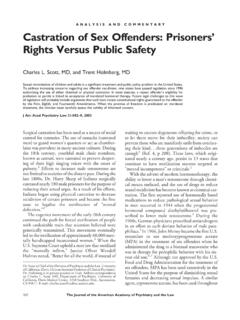Transcription of Incapacitating Motherhood
1 2191 Incapacitating Motherhood Priscilla A. Ocen* Incapacitation, the removal of dangerous people from society, is one of the most significant penal rationales in the United States. Mass incarceration emerged as one of the most striking applications of this theory, as policy makers shifted from rehabilitative efforts toward incapacitation in jails and prisons across the country. Women have been uniquely devastated by this shift toward incapacitation. Indeed, the United States is home to the largest and fastest growing women s prison population in the world.
2 Of the women incarcerated in jails and prisons, nearly seventy percent were the primary caretakers of small children at the time of their arrest and approximately eighty percent are of reproductive age. Notwithstanding these alarming trends, the gendered dimensions of incapacitation have largely been underexplored in the scholarly literature. Rather, women s incarceration has been theorized as an unintended consequence of the punitiveness directed toward Black men. This Article aims to bridge this discursive gap by highlighting the specific ways in which incapacitation has been used as a means to regulate the bodies and reproductive capacities of marginalized women.
3 The Article advances this claim in three ways. First, by mapping the historical function of women s prisons as a mechanism to restore and regulate fallen women who deviated from traditional norms associated with femininity and Motherhood . Second, by examining the ways in which contemporary women s prisons similarly regulate women s identities as * Copyright 2018 Priscilla A. Ocen. Associate Professor of Law, Loyola Law School Los Angeles. The Article benefitted from presentations at the African American Policy Forum s Social Justice Writer s Retreat, the Yale Law School Critical Race Theory Conference, the Critical Justice Scholars Workshop, Seattle University and the University of Miami School of Law.
4 I am indebted to Amna Akbar, Paul Butler, Brietta Clark, Devon Carbado, Kimberl Crenshaw, Kimberly West Faulcon, Michele Goodwin, Justin Hansford, Luke Harris, Kathleen Kim, Douglas NeJaime, Yxta Murray, Camille Gear Rich, Nicole Scott and Jocelyn Simonson for their insightful feedback on previous drafts of this Article. This project would not have been possible without the able research assistance of Loyola Law School Research Librarian Caitlin Hunter and the research support provided by Priscilla Ankarah, Kaelee Maldanaldo, and Angela Winzey. 2192 University of California, Davis [Vol.]
5 51:2191 mothers. Instead of attempting to rehabilitate women, however, contemporary women s prisons incapacitate women who engage in behavior or possess characteristics that diverge from traditional maternal norms. Indeed, through what the Article terms the incapacitation of Motherhood , women prisoners are alienated from their children, denied reproductive care, humiliated during pregnancy and postpartum recovery, and in some cases, sterilized. Lastly, contesting these practices and the incapacitation of Motherhood , this Article calls for the use of a robust legal framework, informed by the principles of reproductive justice that are more protective of the reproductive capacities of incarcerated women.
6 TABLE OF CONTENTS INTRODUCTION .. 2193 I. CAPTURING Motherhood : INCAPACITATION AND EARLY EFFORTS TO REGULATE REPRODUCTION .. 2201 A. Motherhood as a Biological Imperative .. 2204 B. Early Women s Prisons and the Regulation of Motherhood .. 2206 1. Establishment of Women s Prisons .. 2208 2. Race, Reformatories, and the Redemption of Fallen Women .. 2211 C. Decline of Women s Prisons as an Explicit Form of Reproductive Control .. 2213 II. Incapacitating Motherhood : MASS INCARCERATION AS A CONTEMPORARY MEANS OF CONTROLLING DANGEROUS MOTHERS .. 2213 A. Incapacitating Motherhood Through Medical Neglect.
7 2217 B. Incapacitating Motherhood Through Degrading Treatment .. 2219 C. Incapacitating Motherhood Through Separation from Children .. 2221 D. Incapacitating Motherhood Through Termination of Parental Rights .. 2223 E. Incapacitating Motherhood Through sterilization .. 2227 III. OVERINCARCERATED AND UNDERPROTECTED: HOW CONSTITUTIONAL DOCTRINE FACILITATES THE INCAPACITATION OF Motherhood .. 2229 A. Constitutional Deference and the Incapacitation of Motherhood .. 2229 B. Due Process and the Incapacitation of Motherhood .. 2231 1. Substantive Due Process and the (Nonexistent) Right to Procreate.
8 2231 2018] Incapacitating Motherhood 2193 2. Substantive Due Process and the Limited Right to Familial Visitation .. 2233 C. The Eighth Amendment and Incapacitation of Motherhood .. 2235 IV. LIBERATING Motherhood : RESISTING REPRODUCTIVE INCAPACITATION THROUGH REPRODUCTIVE JUSTICE .. 2237 A. Reproductive Justice .. 2238 B. From the Incapacitation of Motherhood to Reproductive Justice .. 2241 2245 INTRODUCTION Ms. Jones1 was a tall African-American woman in her late thirties. She was incarcerated at the Valley State Prison for Women ( VSPW ) in rural Chowchilla, Her short haircut and oversized blue and white prison uniform, however, made her look much younger.
9 Ms. Jones asked to meet with me as part of a legal visit arranged by the California Coalition for Women Prisoners3 and the San Francisco Lawyers Committee for Civil According to her intake form, she was concerned about issues related to the treatment of pregnant women and custody of her newborn son. When we sat down to talk, she was quiet and pensive. I just had a baby boy. I went through so much and I need to make sure I don t lose him, she whispered, seemingly trying to wrest as much privacy and dignity as she could muster in the cavernous visiting room. Ms. Jones went on to describe the joys and pains of her birthing process as well as her anxieties surrounding her child s wellbeing.
10 1 Client s name has been changed to preserve privacy and confidentiality. 2 Valley State Prison, WIKIPEDIA, (last visited Oct. 26, 2017). 3 The California Coalition for Women Prisoners is a grassroots social justice organization, with members inside and outside prison, that challenges the institutional violence imposed on women, transgender people, and communities of color by the prison industrial complex. About Us, CAL. COAL. FOR WOMEN PRISONERS, (last visited Jan. 23, 2016). 4 Lawyers Committee for Civil Rights of the San Francisco Bay Area is a legal civil rights organization that works to advance, protect and promote the legal rights of communities of color, and low-income persons, immigrants, and refugees.

